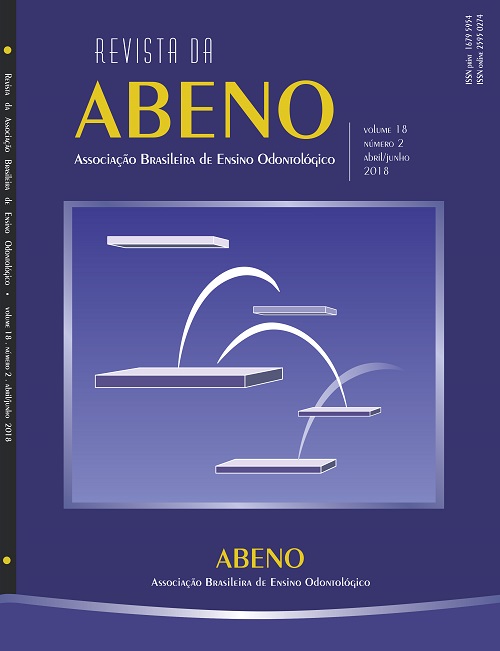New proposal for teaching/training in caries lesions’ detection: insights from the implementation of the method among undergraduate students
DOI:
https://doi.org/10.30979/rev.abeno.v18i2.438Keywords:
Dental Caries. Education, dental. DentistryAbstract
The present study proposes a method for the teaching of the detection and evaluation of caries lesions, using the International Caries Detection and Assessment System (ICDAS) as an auxiliary tool. Sixty-two students in the fourth year of the undergraduate course in Dentistry of the University of São Paulo underwent three training activities for the use of the ICDAS, applied in different moments: regular theoretical class, activity with images projection and practical-laboratory activity. The students answered questionnaires, before and after the activities, to evaluate the knowledge and the perception about them. A practical evaluation was also performed, with evaluation of extracted teeth. After the laboratory exercises, the mean number of correct answers to conceptual questions increased significantly and remained until the end of the laboratory activity. Those who believed to be well prepared at the beginning of the activity had three times more chances to reach a score above 5 in the second moment of the practical-laboratory activity (OR = 3.1; 95% CI = 1.0 - 9.1). It was concluded that the practical-laboratory activity contributes to the learning of undergraduate students in the detection of caries lesions, including healing conceptual doubts that may exist after the theoretical class. However, the student's perception may not be impacted by the activity.
Downloads
References
Pitts N, Melo P, Martignon S, Ekstrand K, Ismail A. Caries risk assessment, diagnosis and synthesis in the context of a European Core Curriculum in Cariology. Eur J Dent Educ. 2011;15(1):23-31.
Schulte AG, Pitts NB, Huysmans MCDNJM, Splieth C, Buchalla W. European Core Curriculum in Cariology for undergraduate Dental
students. Caries Res. 2011;45(4):336-45.
Pitts N. "ICDAS" - an international system for caries detection and assessment being developed to facilitate caries epidemiology, research and appropriate clinical management. Community Dent Health. 2004;21(3):193-8.
Ismail A. Visual and visuo-tactile detection of dental caries. J Dent Res. 2004;83:56-66.
Burt BA, Kolker JL, Sandretto AM, Yuan Y, Sohn W, Ismail AI. Dietary patterns related to caries in a low-income adult population. Caries Res. 2006;40(6):473-80.
Nyvad B, Fejerskov O. Assessing the stage of caries lesion activity on the basis of clinical and microbiological examination. Community Dent Oral Epidemiol. 1997;25(1):69-75.
Nyvad B. Diagnosis versus detection of caries. Caries Res. 2004;38(3):192-8.
Gimenez T, Piovesan C, Braga MM, Raggio DP, Deery C, Ricketts DN, et al. Visual inspection for caries detection: a systematic review and meta-analysis. J Dent Res. 2015;94(7):895-904.
Diniz MB, Lima LM, Santos-Pinto L, Eckert GJ, Zandoná AGF, de Cássia Loiola Cordeiro R. Influence of the ICDAS e-learning program for occlusal caries detection on dental students. J Dent Educ. 2010;74(8):862-8.
Marteau TM, Bekker H. The development of a six-item short-form of the state scale of the Spielberger State-Trait Anxiety Inventory (STAI). Br J Clin Psychol. 1992;31(3):301-6.
Assaf AV, de Castro Meneghim M, Zanin L, Tengan C, Pereira AC. Effect of different diagnostic thresholds on dental caries calibration - a 12 month evaluation. Community Dent Oral Epidemiol. 2006;34(3):213-9.
Braga MM, Oliveira LB, Bonini GAVC, Bönecker M, Mendes FM. Feasibility of the International Caries Detection and Assessment System (ICDAS-II) in epidemiological surveys and comparability with standard World Health Organization criteria. Caries Res. 2009;43(4):245-9.
Sims MC, Hall DP, Hall N, Archibald AMC, Maxwell SRJ. Teaching medical students prescribing skills: a near-peer approach. Med Educ. 2011;45(11):1144-5.
Huntoon KM, McCluney CJ, Wiley EA, Scannell CA, Bruno R, Stull MJ. Self-reported evaluation of competencies and attitudes by physicians-in-training before and after a single day legislative advocacy experience. BMC Med Educ. 2012;12:47. doi: 10.1186/1472-6920-12-47.
Bissell V, McKerlie RA, Kinane DF, McHugh S. Teaching periodontal pocket charting to dental students: a comparison of computer assisted learning and traditional tutorials. Br Dent J. 2003;195(6):333-6.
Woelber JP, Hilbert TS, Ratka-Krüger P. Can easy-to-use software deliver effective e-learning in dental education? A randomised controlled study. Eur J Dent Educ. 2012;16(3):187-92.
Katajavuori N, Hakkarainen K, Kuosa T, Airaksinen M, Hirvonen J, Holm Y. Curriculum reform in Finnish pharmacy education. Am J Pharm Educ. 2009;73(8):151.
Rashid MS, Sobowale O, Gore D. A near-peer teaching program designed, developed and delivered exclusively by recent medical graduates for final year medical students sitting the final objective structured clinical examination (OSCE). BMC Med Educ. 2011;11:11. doi:10.1186/1472-6920-11-11.
Ashley FA, Gibson B, Daly B, Baker SL, Newton JT. Undergraduate and postgraduate dental students’ “reflection on learning”: a qualitative study. Eur J Dent Educ. 2006;10(1):10-9.
Ruohoniemi M, Parpala A, Lindblom-Ylanne S, Katajavuori N. Relationships between students' approaches to learning, perceptions of the teaching-learning environment, and study success: a case study of third-year veterinary students. J Vet Med Educ. 2010;37(3):282-8.
Downloads
Published
How to Cite
Issue
Section
License
Autores que publicam nesta revista concordam com os seguintes termos:
a) Autores mantém os direitos autorais e concedem à revista o direito de primeira publicação, com o trabalho simultaneamente licenciado sob a Licença Creative Commons Attribution que permite o compartilhamento do trabalho com reconhecimento da autoria e publicação inicial nesta revista.
b) Autores têm autorização para assumir contratos adicionais separadamente, para distribuição não-exclusiva da versão do trabalho publicada nesta revista (ex.: publicar em repositório institucional ou como capítulo de livro), com reconhecimento de autoria e publicação inicial nesta revista.
c) Autores têm permissão e são estimulados a publicar e distribuir seu trabalho online (ex.: em repositórios institucionais ou na sua página pessoal) a qualquer ponto antes ou durante o processo editorial, já que isso pode gerar alterações produtivas, bem como aumentar o impacto e a citação do trabalho publicado (Veja O Efeito do Acesso Livre).






